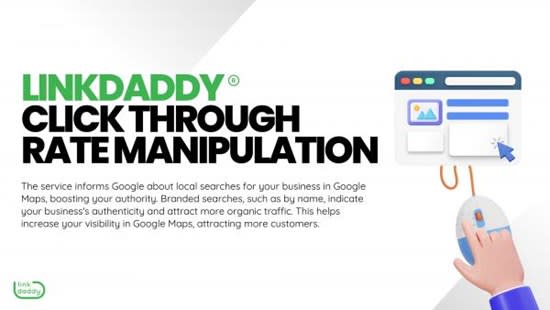The Art and Scientific Research of CTR Manipulation Explained
The adjustment of Click-Through Price (CTR) is a nuanced discipline that marries mental insights with analytical roughness, essential for driving individual engagement in an affordable digital landscape. Marketing professionals utilize various methods, from engaging headings to critical color selections, to catch interest and punctual activity. The performance of these methods hinges on a complete understanding of individual actions and honest considerations that can not be forgotten. As we explore this complex equilibrium, it ends up being apparent that the effects of CTR adjustment prolong far beyond plain numbers, motivating a closer examination of its more comprehensive influence.
Comprehending Click-Through Price
Click-through rate (CTR) is a crucial statistics for examining the effectiveness of electronic advertising campaigns. Understanding CTR is crucial for marketers intending to enhance their methods and improve user interaction.
CTR is calculated utilizing the formula: (Complete Clicks/ Total Perceptions) x 100. This straightforward estimation enables marketers to examine the performance of different electronic assets, such as email projects, social networks posts, or pay-per-click ads - CTR Manipulation Press Release. Monitoring CTR assists recognize trends, enabling data-driven decisions to improve web content and targeting strategies
It is very important to note that while a high CTR is desirable, it ought to not be the sole focus. An extensive evaluation should likewise take into consideration other metrics, such as conversion price and return on financial investment (ROI), to gauge general project success. By assessing and understanding CTR, marketers can properly improve their electronic advertising initiatives, inevitably bring about improved company results.
Mental Triggers for Interaction
To effectively drive user involvement, online marketers need to touch into different mental triggers that influence decision-making and habits. Recognizing these triggers can boost the effectiveness of advertising and marketing approaches and boost click-through prices (CTR)
 When users believe an offer is uncommon or time-sensitive, they are more most likely to act rapidly to stay clear of missing out on out. Highlighting testimonies, individual reviews, or showcasing popular items can create a sense of count on and motivate users to engage.
When users believe an offer is uncommon or time-sensitive, they are more most likely to act rapidly to stay clear of missing out on out. Highlighting testimonies, individual reviews, or showcasing popular items can create a sense of count on and motivate users to engage.An additional essential factor is using sob stories. Web content that evokes strong feelings, whether pleasure, curiosity, or urgency, can compel individuals to click. Additionally, the concept of reciprocity, where people feel obliged to return supports, can be efficient; offering something useful for cost-free, such as a helpful resource, can entice customers to engage better.
Methods for Effective CTR Control
Using targeted strategies for efficient CTR control includes a critical mix of layout elements, messaging, and target market understanding. One essential method is using compelling headlines that evoke interest or necessity. Headings have to be clear, succinct, and straightened with the target market's passions to record focus quickly.
 Additionally, making use of top quality visuals can substantially boost CTR. Pictures should be appropriate and interesting, as they can create an emotional connection, triggering customers to click with. Incorporating contrasting shades for call-to-action buttons can likewise draw interest and increase click prices.
Additionally, making use of top quality visuals can substantially boost CTR. Pictures should be appropriate and interesting, as they can create an emotional connection, triggering customers to click with. Incorporating contrasting shades for call-to-action buttons can likewise draw interest and increase click prices.Another reliable approach is A/B testing various components of your web content, such as duplicate variants and design styles - GMB CTR Manipulation. This repetitive process permits marketing professionals to recognize which parts reverberate most with their audience
Moreover, customization plays an essential role; try here tailoring web content based upon user behavior and preferences can cause greater engagement. Crafting messages that deal with certain discomfort factors or requirements improves importance and encourages clicks.
Finally, guaranteeing that touchdown web pages are maximized for mobile phones is crucial, as a considerable section of users browse on mobile phones. These strategies, when executed thoughtfully, can cause considerable improvements in CTR and overall project performance.
Studying Data for Better Results
How can information evaluation change your CTR adjustment methods? The application of robust information analysis techniques can significantly boost the performance of your click-through rate (CTR) adjustment efforts.
Moreover, leveraging A/B testing results supplies understandings into Recommended Reading which variants of your content return higher CTRs. By continuously repeating on these findings, you can refine your approach, making sure that each piece of material is strategically crafted to capture focus. Furthermore, utilizing logical devices to keep track of time invested on pages and bounce prices can assist you recognize the elements that add to customer involvement.
Additionally, segmenting your data based upon web traffic sources enables you to identify which networks are most efficient in driving clicks. This understanding can guide your advertising efforts towards high-performing platforms. Inevitably, data evaluation is not just an auxiliary tool; it is an essential element that can drive impactful CTR techniques, eventually leading to enhanced involvement and conversion prices.
Ethical Factors To Consider in CTR Approaches
Browsing the complexities of CTR adjustment needs a careful evaluation of moral considerations that underpin reliable advertising methods. As services aim to boost click-through rates, they must balance aggressive methods with the integrity of their messaging. Misleading individuals with misleading practices, such as clickbait or incorrect marketing, not only deteriorates consumer depend on yet can additionally cause reputational damage and legal effects.
Morally sound CTR strategies focus on transparency and precision. Marketing experts must make sure that the content delivered aligns with user assumptions and supplies genuine value.
As marketing experts analyze individual actions to optimize CTR, they need to adhere to policies and respect consumer legal rights pertaining to data usage. By focusing on honest standards in CTR manipulation, businesses can cultivate a lasting advertising and marketing setting that benefits both the organization and its target market. CTR Manipulation.
Verdict
Finally, the art additional reading and science of Click-Through Price (CTR) manipulation incorporate a multifaceted method, incorporating emotional triggers, tactical methods, and robust data evaluation. While enhancing individual interaction continues to be a primary purpose, honest factors to consider have to guide these techniques to make sure openness and foster trust fund. Stabilizing reliable CTR control with adherence to privacy laws is vital for lasting involvement, inevitably lining up marketing techniques with customer assumptions and advertising a favorable digital atmosphere.
The control of Click-Through Rate (CTR) is a nuanced discipline that marries mental insights with analytical roughness, vital for driving user interaction in an affordable digital landscape. Comprehending CTR is essential for marketing professionals aiming to enhance their techniques and enhance customer involvement. The application of robust information analysis techniques can significantly enhance the effectiveness of your click-through price (CTR) control efforts. As online marketers analyze customer actions to maximize CTR, they need to adhere to regulations and regard customer legal rights concerning data usage. Stabilizing reliable CTR manipulation with adherence to personal privacy policies is important for lasting interaction, inevitably lining up marketing techniques with individual assumptions and promoting a favorable electronic environment.
 Hallie Eisenberg Then & Now!
Hallie Eisenberg Then & Now! Kelly McGillis Then & Now!
Kelly McGillis Then & Now! Tiffany Trump Then & Now!
Tiffany Trump Then & Now! James Van Der Beek Then & Now!
James Van Der Beek Then & Now! Mary Beth McDonough Then & Now!
Mary Beth McDonough Then & Now!